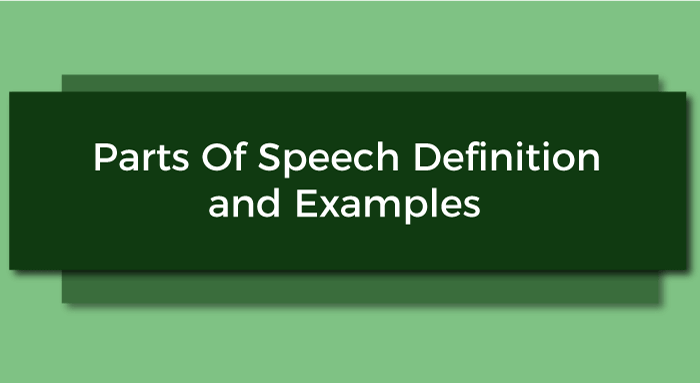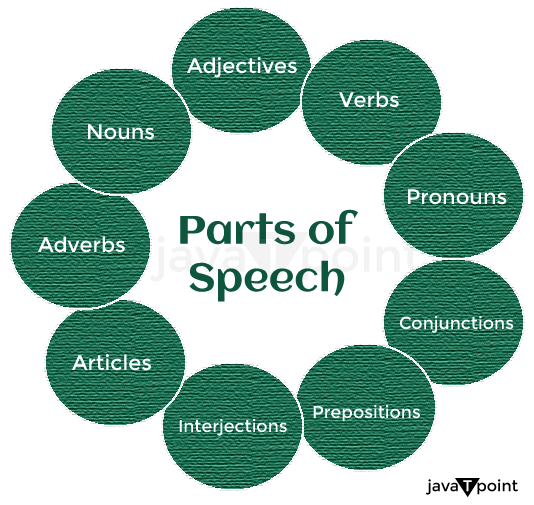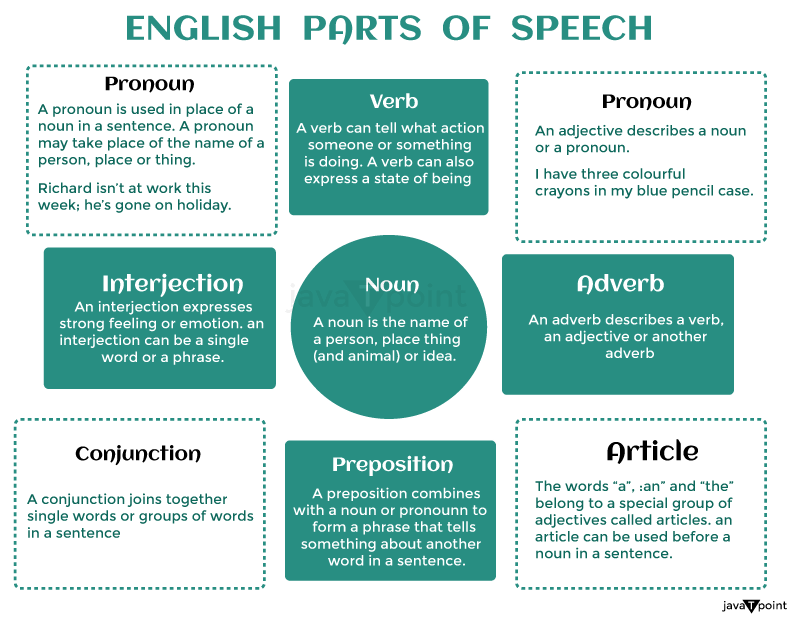9 Parts of Speech Definitions and ExamplesEach word in a language can be classified according to its part of speech. Parts of speech explain what a word does, how it works, and how it conveys meaning. We also divide elements of speech into lexical words, which have a lot of significance, and function words, which assist us create sentences and indicate relationships. 
In conventional grammar, a part of speech is one of the nine primary categories into which words are grouped based on their roles in statements, such as nouns or verbs. These are the basic blocks of grammar, also referred to as word classes. What are the English Parts of Speech?In English, there are 9 parts of speech. These components of speech, when combined, constitute the foundation for establishing meaning in language:
Each part of speech performs a different function and can be employed in a variety of ways.
What is the Meaning and Definition of "Parts of Speech"?The function of the word is determined by the context in which it is used. Parts of speech are essential in language acquisition because they assist pupils grasp how sentences are produced and meaning is delivered. We've all heard of nouns, pronouns, adjectives, verbs, adverbs, prepositions, conjunctions, articles/ determiners and interjections. They are the classifications into which words are classified based on their function in a sentence. Students may strengthen their writing skills by employing more precise and diverse sentence structures after learning about elements of speech. For instance, "dog" is a noun, whereas "swiftly" is an adverb. There are two types of direct objects: content words as well as structure words. Nouns, verbs, adjectives, and adverbs are examples of content words. These are the words in a sentence that convey meaning. Why Study Parts of Speech?As mentioned above Parts of Speech form the basis of English Grammar Language. Understanding the parts of speech is a fantastic place to start if you're looking to study and master English Language. They can assist you in understanding the structure of the language and guiding you through the language. If you master it, you can efficiently communicate in English Language by writing or speaking Word Classes: Open and ClosedOpen and closed parts of speech are the two primary sorts of word classes. Nouns, verbs, adjectives, and adverbs are examples of open word classes, frequently recognized as content words. They are termed such as new members can be introduced to them (open class), as contrast to closed word classes (e.g., prepositions, conjunctions, determiners), which have a considerably smaller number of members (closed class). Closed classes, which often only convey grammatical details, are usually less important to the meaning of a phrase than open classes. For instance, in the statement. "The small kitty meowed," the words "small" and "kitty" are more important to the sentence's significance than the word "the," which just indicates that we are discussing about a kitten/ kitty. 
The 9 Parts of Speech1. NounA noun is a term that relates to someone, somewhere, something, or an idea. Nouns are frequently employed as a statement's subject or object. They can be the subject of a verb (I saw the dog) or a preposition (We went for some exercise in the playground). Nouns can also be classified as:
Others, in alongside these, include:
Examples of Noun
In English, nouns can be singular or plural. We just include -s or -es to the very end of a noun to create a regular plural. This criterion does not apply to irregular plurals. 2. PronounsIn English, pronouns are essential the parts of speech. A pronoun is a word that replaces a noun or noun phrase. Pronouns are utilized when referring directly or indirectly to individuals or objects. With the help of pronouns learners can avoid repeating the noun again and again. It helps in eliminating unnecessary usage of nouns The following are the most popular pronouns:
Note: All these are possessive pronouns.Apart from the possessive pronoun there are also reflexive and relative pronouns. Pronouns are frequently seen following the noun or phrase they are substituting. For instance, "I saw Peter in the field." He was playing badminton. "I" is a pronoun that replaces the speaker's identity in this statement. "He" is a pronoun that replaces Peter in the following sentence. Instead of repeating Peter's name; a pronoun is used "he." Pronouns can also be used to describe yourself: "I'm heading to the bookstore." "I" is a reflexive pronoun in this context since it refers back to the statement's subject. For introducing clauses, relative pronouns are used: "The gentleman who was at the bookstore was looking for a novel." "Who" is a relative pronoun in the statement that begins the clause "who was at the bookstore." The noun to which a pronoun alludes is known as its antecedent.In English, pronouns change form to indicate whether they pertain to the singular or plural, subject or things, male or female, or none. Here are a few instances of basic pronouns:
3. VerbOne of the nine parts of speech is the verb. These are words that describe an action or a state of being. Verbs are typically expressed in English through the suffix "-ed" that follows the root form of the word, as in "talk-ed," "play-ed," and "fix-ed." The root form is often referred to as the base form. Verbs are classified into three types:
Words that represent physical or mental activities include "walk," "hop," "write," and "think." Linking verbs are words that tie the subject to a word or complete sentence that characterizes or defines it. They include words like "is," "seems," and "becomes." Helping verbs supplement the main verb in a statement by providing an additional information regarding time, tense, mood, or situation, and they incorporate words like "can," "should," and "would." In English, all three types of verbs are required for sentence construction. It is critical to understand how to use them correctly in order to communicate effectively. The main verb of a statement has a subject, which is usually a noun or pronoun alluding to the person or thing being discussed in the statement. In the statement Julie jumps, for example, the verb is jumps and the subject is Julie. To 'agree with' the subject, verbs can alter their form. Here are some verb instances:
In the last example, a verb may consist of more than one word. This is known as a compound verb. Main verbs and helping verbs (sometimes known as auxiliary verbs) are the two sorts of verbs. 
4. AdjectiveOne of the nine parts of speech are adjectives. They change verbs, nouns, and adjectives to express the degree, shape, dimensions, age, color, origin, and material of the items they change. Examples include "a hot rod," "an oval ball," "an old bike," and "Cuban cigarettes." Adjectival meanings are normally used prior to the noun or pronoun they alter, but they can sometimes be found after it: "He is fast." "That bike is mine." When two or more adjective classes alter the same noun, they are often listed in the following sequence:
Here are some adjective instances:
Note: The adjectives have been highlighted for your reference.5. AdverbsAdverbs are words that modify verbs, adjectives, or other adverbs. Adverbs in English are often produced by appending the suffix "-ly" to an adjective, as in "patiently" and "quickly." Adverbs can describe the manner, degree, frequency, time, place, or other characteristics of an activity. The adverb "patiently" in the statement "He carefully strolled across the hall" changes the verb "strolled." The word gradually describes his walking style. In the same way, the adverb "swiftly" in the sentence "She swiftly ran out of the house" changes the verb "ran." The word "swiftly" describes how fast she raced. Adverbs can also be found in words like: Here, there, now, then etc Adverbs can come either prior to or following the word they alter. In general, they come after verbs prior to adjectives and other adverbs. Here are some examples of Adverbs in a sentence;
Note: The adverbs have been highlighted for your reference.6. PrepositionsA preposition is a term (typically a short word) that indicates the connection between two components of a phrase. A preposition is frequently followed by a noun or a pronoun. To put it straightforwardly, prepositions are words that come before (pre-position) nouns or pronouns to relate them to other elements of speech in a statement. There are various types of prepositions that provide distinct types of information: time prepositions, place prepositions, and direction prepositions. For instance in the statement, "I looked for my wristwatch under the table,", the word "under" is a preposition that indicates the link between "I" and "my wristwatch." The word "under" indicates the location of the watch. Here are few more examples of prepositions; In; On; Before; After; During; By; Across; Above; Since; Over; Behind; At; Below; Under etc Several of these prepositions have multiple meanings as well. A preposition's meaning is frequently related to time or place. Some estimate there are only about 150 prepositions in English, while others believe there are closer to 250. It's difficult to be precise because new words are constantly being coined. Furthermore, some words can be used in more than one context.' Here are few examples of prepositions in the sentence;
Note: The prepositions have been highlighted for your reference.7. ConjunctionsConjunctions are a type of part of speech. They are words that connect other words, phrases, or clauses. Conjunctions are classified into three types:
Coordinating conjunctions connect two important words, phrases, or clauses. Coordination conjunctions that are commonly used are "and," "but," and "or." Coordinating conjunctions link two sentences of equal significance to form what is known as a compound sentence. There aren't a lot of coordinating conjunctions. You can recall them by the abbreviation FANBOYS, which stands for for, and, nor, but, or, yet, so. Subordinate clauses are joined to the main clause by subordinating conjunctions. Subordinating conjunctions that are commonly used are "after," "although," as well as "because." When we link clauses with subordinating conjunctions, we are emphasizing one clause over the other. A subordinate clause is a less important clause. A complicated sentence is made up of two or more clauses joined by subordinating conjunctions. Correlative conjunctions are utilized in pairs to unite two words, phrases, or clauses of comparable value. Correlative conjunctions that are commonly used are "both...and," "either...or," and "neither...nor." Conjunctions, despite their modest size, play a significant part in sentence building. Sentences would be jagged and hard to understand without them. Examples of Conjunctions in the sentence are;
Note: The conjunctions have been highlighted for your reference.8. Determiners and ArticlesArticles and determiners are words that serve to modify nouns. They can showcase whether a noun is particular or generic, and they can also suggest possession. Articles are classified into two types:
Articles can be difficult to understand, but the basic principle is that we employ indefinite articles when we present a fresh noun to our readers or when we aren't referring to something in particular. Conversely, we use definite articles to refer to a particular thing that our audience members are already familiar with. Note: You may come across articles that state that articles are a form of adjective. This is untrue. Some people believed this about 300 years ago, but this is no longer the case.Please keep in mind that some grammars classify articles as a category under the umbrella of determiners. There are three kinds of determiners as well:
Although they serve different purposes, both articles and determiners hold significance in communication. Speakers can bring clarity as well as accuracy in their writing and speaking by correctly employing these parts of speech. Examples of Articles and Determiners in the sentence are;
Note: The articles/determiners have been highlighted for your reference.9. InterjectionsAn interjection is a word or phrase that expresses emotion. Also interjection are words that are often utilized with exclamation marks. It is commonly used as a solitary exclamation, as in: "Superb!" "Oh no!" "No way!" "Holy Crap!" "Oops!" "Yipee!" Interjections can also convey exhilaration, surprise, or dismay. They can even be used to fill uncomfortable gaps in conversation in rare circumstances. While interjections aren't always regarded as standard English grammar, they can be helpful in emphasizing or flavoring writing. As a result, they are frequently utilized in fiction and other forms of imaginative writing. However, they should be used sparingly, as too many interjections can make writing appear choppy or unprofessional. Interjections, when utilized correctly, can bring individuality and zest to the writings. Examples of Interjections in the sentence are;
Note: The interjections have been highlighted for your reference.Identifying Parts of SpeechThe initial phase in determining the parts of speech in conventional grammar is to recognize the verb. The verb is the doing word in the phrase, and it comes prior to the subject most of the time. The verb in the statement "The dog napped on the couch," for instance, is "napped." After having recognized the verb, you can move on to the subject. The noun or pronoun functioning as the verb is the subject of the sentence. The subject of our sample sentence, "The dog napped on the couch," is "dog." After you've determined the verb and subject, you can start looking for other parts of speech. Adjectives (descriptive words), adverbs (words that alter verbs), and prepositions (words which demonstrate connections among things) are all common parts of speech. Look for words that appear prior or following verbs and nouns to recognize these parts of speech. In the statement "The black dog napped on the gentle couch," for instance, the color class and adjective "black" modify the adjective noun "dog," and the adjective "gentle" changes the noun "couch." The adverb "on" changes the verb " napped" by indicating the location of the action. By splitting sentences down into its individual parts, you may more clearly recognize the purpose of each word and comprehend how they interact to form a whole concept. When An Expression Is Used in Two Different Ways Of SpeakingThere are some parts of speech in English that can be hard to detect. For instance, the word "you" can serve as a pronoun as well as an adjective. "You" is the person who is the subject of a phrase or clause when utilized as a pronoun. For instance, "You are heading to the shop." "You" alters a noun or pronoun when utilized as an adjective. Understanding the parts of speech and how they work together in a phrase is essential for determining when a word is two different forms of speech. With some practice, you will be able to recognize when a word is utilized in two distinct parts of speech. Common EndingsCommon Noun EndingsThe following are examples of common noun endings: -er -est -s -ed -ing These prefixes alter the literal meaning of a term and frequently indicate whether it is a subject or object. For instance, the verb "read" means "to observe something carefully." "Reader" is a noun phrase that means "one who reads." "Reading" is a gerund that means "the process of reading." You can better grasp the purpose of words in a statement if you know common noun endings. This can assist you avoid grammar mistakes while interacting with greater efficiency. Common Verb EndingsIn English Grammar, there are a few fundamental combinations of verb ends that you will encounter. They are as follows: -s -ed -ing -en Based on the closedness of verbs, each of these endings serves a distinct purpose. The -s suffix indicates present tense verbs, whereas the -ed ending indicates past tense verbs. For verb phrases as well as gerunds, the -ing form is utilized, and for irregular verbs, the -en form is utilized. Common Adjective EndingsAdjectives are a larger category that may describe practically anything, from physical characteristics to psychological qualities. There are dozens of adjective ends in English, but the following are the most prevalent: -able -eous -ful -ic -ing -ish -ive -less -y Common Adverb EndingsAdverbs provide additional information regarding how, when, where, and till what extent an action is performed. In short, they provide extra information about the verbs. Adverb endings that are commonly used involve: -ly -wise -ward(s) -ways -most The most prevalent adverbial phrase suffix is -ly. This is since most adverbs are produced through the addition of -ly to the conclusion of an adjective. The adjective slow, for instance, becomes the adverb slowly. Softly, fearlessly, gladly, yearly, monthly, daily, and so on are other instances. Adverbs are usually identified by their spelling; if they finish in -ly, they are an adverb. Multiple Adjective CommasA decent rule of thumb is to incorporate the comma if leaving it out would change the sense of the phrase. For instance, "the pink, black, and green flag" as opposed to "the pink black and green flag." The colors are distinct (coordinate) descriptor in the first line; in the second statement, they form an all-encompassing cumulative description. The Placement of AdverbsThere are some exemptions to the rule that adverbs follow after the verb. In the statement, "He slowly moves to the gate," for instance, the adverb "slowly" characterizes the verb "moves." Conversely, the phrase "He moved swiftly to the gate" emphasizes how fast he moved. Adverbs can also be used to emphasize the start or finish of a statement. For example, "Sadly, They have to go" highlights the speaker's remorse but "We have to go sadly" stresses the speaker's departure. Adverbs can thus provide a glimpse into the speaker's mood or point of view, adding richness and significance to words.
Next TopicConcrete Noun Definition
|
 For Videos Join Our Youtube Channel: Join Now
For Videos Join Our Youtube Channel: Join Now
Feedback
- Send your Feedback to [email protected]
Help Others, Please Share










